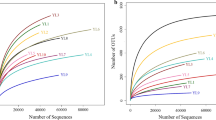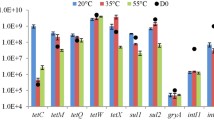Abstract
Due to the enviornmental problems associated with disposal of livestock sludge, many stabilization studies emphasizing on the sludge volume reduction were performed. However, little is known about the microbial risk present in sludge and its stabilized products. This study microbiologically explored the effects of anaerobic lagoon fermentation (ALF) and autothermal thermophilic aerobic digestion (ATAD) on pathogen-related risk of raw swine manure by using culture-independent 16S rDNA cloning and sequencing methods. In raw swine manure, clones closely related to pathogens such as Dialister pneumosintes, Erysipelothrix rhusiopathiae, Succinivibrioan dextrinosolvens, and Schineria sp. were detected. Meanwhile, in the mesophilic ALF-treated swine manure, bacterial community clones closely related to pathogens such as Schineria sp. and Succinivibrio dextrinosolvens were still detected. Interestingly, the ATAD treatment resulted in no detection of clones closely related to pathogens in the stabilized thermophilic bacterial community, with the predominance of novel Clostridia class populations. These findings support the superiority of ATAD in selectively reducing potential human and animal pathogens compared to ALF, which is a typical manure stabilization method used in livestock farms.


Similar content being viewed by others
References
Amann RI, Ludwig W, Schleifer KH (1995) Phylogenetic identification and in situ detection of individual microbial cells without cultivation. Microbiol Rev 59:143–169
Chao A (1984) Nonparametric estimation of the number of classes in a population. Scand J Statist 11:265–270
Chen S, Dong X (2005) Proteiniphilum acetatigenes gen. nov., sp. nov., from a UASB reactor treating brewer wastewater. Int J Sys Evol Microbiol 55:2257–2261
Chénier MR, Juteau P (2009a) Impact of an aerobic thermophilic sequencing batch reactor on antibiotic-resistant anaerobic bacteria in swine waste. Microb Ecol 58:773–785
Chénier MR, Juteau P (2009b) Fate of chlortetracycline- and tylosin-resistant bacteria in an aerobic thermophilic sequencing batch reactor treating swine waste. Microb Ecol 58:86–97
Dzidic S, Bedekovic V (2003) Horizontal gene transfer-emerging multi-drug resistance in hospital bacteria. Acta Pharmacol Sin 24:519–526
Edgar RC (2004) MUSCLE: multiple sequence alignment with high accuracy and high throughput. Nucleic Acid Res 32:1792–1797
Franz E, van Bruggen AHC (2008) Ecology of E. coli O157: H7 and Salmonella enterica in the primary vegetable production chain. Crit Rev Microbiol 34:143–161
Guan TY, Holley RA (2003) Pathogen survival in swine manure environments and transmission of human enteric illness—a review. J Environ Qual 32:383–392
Han I, Lee YS, Park J (2007) Evaluation of microbial risk in soil amended with organic fertilizers from stabilized swine manure waste. Environ Eng Res 12:129–135
Han I, Congeevaram S, Park J (2009) Improved control of multiple-antibiotic-resistance-related microbial risk in swine manure wastes by autothermal thermophilic aerobic digestion. Water Sci Technol 59:267–271
Izquierdo JA, Sizova MV, Lynd LR (2010) Diversity of bacteria and glycosyl hydrolase family 48 genes in cellulolytic consortia enriched from thermophilic biocompost. Appl Environ Microbiol 76:3545–3553
Jewell WJ, Kabrick RM (1980) Autoheated aerobic thermophilic digestion with aeration. Water Environ Fed 52:512–523
Juteau P, Tremblay D, Villemur R, Bisaillon JG, Beaudet R (2005) Analysis of the bacterial community inhabiting an aerobic thermophilic sequencing batch reactor (AT-SBR) treating swine waste. Appl Microbiol Biotechnol 66:115–122
Kelly HG, Melcer H, Mavinic DS (1993) Autothermal thermophilic aerobic digestion of municipal sludges: a one-year, full-scale demonstration project. Water Environ Fed 65:849–861
Kiuchi A, Hara M, Pham HS, Takikawa K, Tabuchi K (2000) Phylogenetic analysis of the Erysipelothrix rhusiopathiae and Erysipelothrix tonsillarum based upon 16S rRNA. DNA Seq 11:257–260
Klare I, Konstabel C, Badstubner D, Werner G, Witte W (2003) Occurrence and spread of antibiotic resistance in Enterococcus faecium. Int J Food Microbiol 88:269–290
Lee JW, Lee HW, Kim SW, Lee SY, Park YK, Han JH, Choi SI, Yi YS, Yun Z (2004) Nitrogen removal characteristics analyzed with gas and microbial community in thermophilic aerobic digestion for piggery waste treatment. Water Sci Technol 49:349–357
Levy SB, Marshall B (2004) Antibacterial resistance worldwide: causes, challenges and responses. Nat Med 10:S122–S129
Matsch LC, Drnevich RF (1977) Autothermal aerobic digestion. J Water Pollut Control Fed 49:296–310
Mavinic DS, Mahendraker V, Sharma A, Kelly HG (2001) Effect of microaerophilic conditions on autothermal thermophilic aerobic digestion process. J Environ Eng 127:311–316
Orsbur BC, Melville SB, Popham DL (2010) EtfA catalyses the formation of dipicolinic acid in Clostridium perfringens. Mol Microbiol 75:178–186
Peck MW (2009) Biology and genomic analysis of Clostridium botulinum. Adv Microb Physiol 55:183–265
Pell AN (1997) Manure and microbes: public and animal health problem? J Dairy Sci 80:2673–2681
Peu P, Brugère H, Pourcher A, Kèrourèdan M, Goden J, Delgenès J, Dabert P (2006) Dynamics of a pig slurry microbial community during anaerobic storage and management. Appl Environ Microb 72:3578–3585
Rainey FA, Fritze D, Stackebrandt E (1994) The phylogenetic diversity of thermophilic members of the genus Bacillus as revealed by 16S rDNA analysis. FEMS Microbiol Lett 115:205–211
Rainey FA, Zhilina TN, Boulygina ES, Stackebrandt E, Tourova TP, Zavarzin GA (1995) The taxonomic status of the fermentative halophilic anaerobic bacteria: description of Haloanaerobiales ord. nov., Halobacteroidaceae fam. nov., Orenia gen. nov. and further taxonomic rearrangements at the genus and species level. Anaerobe 1:185–199
Ramirez N, Abel-Santos E (2010) Requirements for germination of Clostridium sordellii spores in vitro. J Bacteriol 192:418–425
Roudiere L, Jean-Pierre H, Comte C, Zorgniotti I, Marchandin H, Jumas-Bilak E (2007) Isolation of Schineria sp. from a man. Emerg Infect Dis 13:659–661
Shannon CE, Weaver W (1949) The mathematical theory of communication. University of Illinois, Urbana, p 117
Simankova MV, Chernych NA, Osipov GA, Zavarzin GA (1993) Halocella cellulolytica gen. nov., sp. nov., a new obligately anaerobic, halophilic, cellulolytic bacterium. Syst Appl Microbiol 16:385–389
Snell-Castro R, Goden J, Delgenès J, Dabert P (2005) Characteristics of the microbial diversity in a pig manure storage pit using small subunit rDNA sequence analysis. FEMS Microbiol Ecol 52:229–242
Sonnleitner B, Fiechter A (1983) Bacterial diversity in thermophilic aerobic sewage sludge (II) types of organisms and their capacities. Appl Microb Biotechnol 18:174–180
Southern PM Jr (1975) Bacteremia due to Succinivibrio dextrinosolvens: report of a case. Am J Clin Pathol 64:540–543
Staton KL, Alleman JE, Pressley RL, Eloff J (2001) Second generation autothermal thermophilic aerobic digestion: conceptual issues and process advancements. San Diego, WEF/AWWA/CWEA Joint Residuals and Biosolids Management Conference
Talbot G, Roy CS, Topp E, Beaulieu C, Palin M, Messè DI (2009) Multivariate statistical analysis of rDNA and rRNA fingerprint data to differentiate microbial communities in swine manure. FEMS Microbiol Ecol 70:540–552
Tamura K, Dudley J, Nei M, Kumar S (2007) MEGA4: molecular evolutionary genetics analysis (MEGA) software version 4.0. Mol Biol Evol 24:1596–1599
Taylor LH, Latham SM, Woolhouse ME (2001) Risk factor for human disease emergence. Phil Trans R Soc Lond 356:983–989
Tsai CR, Garcia JL, Patel BKC, Cayol JL, Baresi L, Math RA (1995) Haloanaerobium alcaliphilum sp. nov., an anaerobic moderate halophile from the sediments of Great Salt Lake, Utah. Int J Syst Bacteriol 45:301–307
Ugwuanyi JO, Harvery LM, McNeil B (2008) Diversity of thermophilic populations during thermophilic aerobic digestion of potato peel slurry. J Appl Microbiol 104:79–90
UN Division of Sustainable Development (2000) Changing consumption and product patterns: organic agriculture, background paper 4. Department of Economic and Social Affairs, UN, New York
US EPA (1990) Environmental regulations and technology: autothermal thermophilic aerobic digestion of municipal wastewater sludge. USEPA Office of Research and Development, Washington DC, EPA/625/10-90/007
US EPA (2003) NPDES permit writers’ guidance manual and example NPDES permit for concentrated animal feeding operations. EPA-833-B-04-001. Washington, DC
Venglovsky J, Jose Martinez J, Placha I (2006) Hygienic and ecological risks connected with utilization of animal manures and biosolids in agriculture. Livest Sci 102:197–203
Watanabe H, Kitamura T, Ochi S, Ozaki M (1997) Inactivation of pathogenic bacteria under mesophilic and thermophilic condition. Wat Sci Tech 36:25–32
Weisburg WG, Barns SM, Pelletier DA, Lane DJ (1991) 16S ribosomal DNA amplification for phylogenetic study. J Bacteriol 173:697–703
Willems A, Collins MD (1995) Phylogenetic placement of Dialister pneumosintes (formerly Bacterioides pneumosintes) within the Sporomusa subbranch of the Clostridium subphylum of the gram-positive bacteria. Int J Syst Bacteriol 45:403–405
Zabranska J, Dohanyos M, Jenicek P, Ruzicikova H, Vranova A (2003) Efficiency of autothermal thermophilic aerobic digestion and thermophilic anaerobic digestion of municipal wastewater sludge in removing Salmonella spp. and indicator bacteria. Water Sci Technol 47:151–156
Acknowledgment
This research was supported by WCU (World Class University) program through the National Research Foundation of Korea funded by the Ministry of Education, Science and Technology (R33-10076).
Author information
Authors and Affiliations
Corresponding author
Electronic supplementary material
Below is the link to the electronic supplementary material.
Supplementary Table 1
Average removals of organics, volatile suspended solids (VSS), and nutrients from swine manure after 4 days of the pilot-scale ATAD operation (unit = mg/L) (DOC 32 kb)
Supplementary Table 2
Clone sequence IDs and their GenBank accession numbers (DOC 151 kb)
Rights and permissions
About this article
Cite this article
Han, I., Congeevaram, S., Ki, DW. et al. Bacterial community analysis of swine manure treated with autothermal thermophilic aerobic digestion. Appl Microbiol Biotechnol 89, 835–842 (2011). https://doi.org/10.1007/s00253-010-2893-8
Received:
Revised:
Accepted:
Published:
Issue Date:
DOI: https://doi.org/10.1007/s00253-010-2893-8




